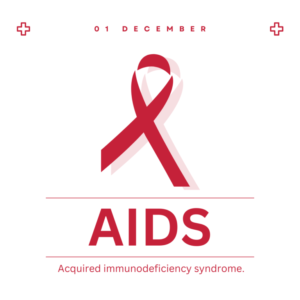AIDS (Acquired immunodeficiency syndrome).
AIDS (Human Immuno Deficiency Virus)
Define AIDS : It is a fatal illness caused by a retrovirus known as human immuno deficiency virus which breaks down the body’s immune system.
we have described :
Routes of transmission of AIDS
Who are the people at risks of having AIDS?
Clinical Features of AIDS
How to Control of AIDS.
Prevention of AIDS
Treatment of AIDS

Causative Organism : Human Immunodeficiency Virus (HIV).
Incubation Period : is 6 months to 5 years or more.
Routes of transmission of AIDS:
- Sexual transmission
- Vaginal sex.
- Anal Sex
- Oral Sex.
2.. Parenteral transmission :
- Blood and blood products.
- Contaminated needles, syringes and surgical instruments.
- Drug abusers.
3.. From mother to baby :
- Transplacental.
- During birth.
- Breast feeding.
4.. Others :
- Embarrassing or kissing (social)
- Touching hand shaking or hugging
- Sharing bathroom or toilet.
- Coughing, Saliva or sneezing.
- Eating together or sharing utensils.
- Swimming pools.
- Sharing clothes.
- Mosquito bite. Insect bite or houseflies.
- Patient caring.
Which are the people at risks of having AIDS :
- Have unprotected sex ( do not use condoms).
- Have multiple sex partners.
- Are a man who has sex with other men.
- Have high – risk partners (s) ( Partner has multiple sex partners, is am man who has sex with other men, or injects drug)
- Have or have recently had a sexually transmitted disease, such as syphilis.
Stages of HIV infection :
- Acute infection : is often asymptomatic.
- Seroconversion may be accompanied by a transient illness : fever, malaise, myalgia, maculopapular rash.
- Asymptomatic infection.
- Persistent generalized lymphadenopathy.
- AIDS related complex : Non – specific constitutional symptoms, minor opportunistic infection.
- AIDS : End stage of HIV infection.
Clinical Features of AIDS :
A. Asymptomatic.
B. Major signs :
- Weight loss > 10 of body weight.
- Chronic diarrhoea for > 1 month.
- Prolonged fever for > 1 month.
C. AIDS – related complex :
- Weight loss.
- Fever.
- Skin rash.
- Lymphadenopathy.
- Diarrhoea
- Herpes simplex.
- Oral candidiasis
- PID
- Tubo – Ovarian mass.
- Thrombocytopenia.
Investigation of AIDS:
- Detection of anti-HIV antibody in serum.
- Acute infection may be detected by the presence of p 24 antigen or HIV RNA by PCR and precedes the appearance of IgM and IgG (within 3 months)
- During the asymptomatic period there are high titres of IgG to core and envelope proteins.
- As immunodeficiency develops, IgG titre to core protein falls. And p24 antiginaemia recurs.
- ELISA test : Demonstration of serum antibody to HIV.
- Western bolt test ( immunoblot) : Confirmatory.
- HIV- RNA.
- POlymerase chain reaction (PCR) : It is gold standard for diagnosis.
Treatment of AIDS:
1.Anti- retroviral therapy :
A.. Nucleoside Reverse Transcriptase Inhibitors (NRTIs):
- Zidovudine
- Lamivudine
- Stavudine
- Zalcitabine
B.. Nucleoside Reverse Transcriptase Inhibitors (NRTIs):
- Delviridine.
- Nevirapine
- Efavirenz
C.. Protease inhibitors :
- INdinavir.
- Saquinavir.
- Ritonavir
- Amprenavir.
D.. Fusion inhibitor :
- Enfuvirtide.
2.. Drug Combination :
- Two from NRTIs + one from NNRTIs.
- Two from NRTIs + one from protease in hibitor.
Control of AIDS :
Prevention measure :
- Health and sex education.
- Prevention of blood brone STD transmission
- Control of prostitution
- Social welfare measures.
- Abiding by the law of religion.
Antiretroviral treatment :
Specific prophylaxis : Until more effective antiviral therapy becomes available , the main aim of existing therapies will be to treat the manifestations of AIDS.
Primary health Care :
- Mother – child health care.
- Family planning and education
Prevention of AIDS :
- Public awareness campaigns for HIV
- Safe sex practices :
- Avoidance of indiscriminate sex.
- Avoidance of penetrative sex
- Use of condoms.
3. Regular venereological screening for high risk groups, e.g. Prostitues.
4. Targeting safe sex methods at sex works.
5. Control of STD.
6. Not to share needles, razors and tooth and tooth brushes.
7. Screening of donated blood and also other blood products.
8. Reduction of unnecessary blood transfusions.
9. Perinatal.
- Routine HIV testing in antenatal clinics.
- Avoidance of pregnancy if HIV- seropositive.
- Avoidance of breast feeding.

You are my breathing in, I own few blogs and occasionally run out from to post .
I like this web site because so much useful stuff on here : D.
Aw, this was a very nice post. In thought I would like to put in writing like this additionally – taking time and actual effort to make a very good article… but what can I say… I procrastinate alot and not at all seem to get something done.
Thank you for the sensible critique. Me & my neighbor were just preparing to do a little research on this. We got a grab a book from our area library but I think I learned more from this post. I am very glad to see such magnificent info being shared freely out there.
I have been absent for a while, but now I remember why I used to love this blog. Thank you, I’ll try and check back more frequently. How frequently you update your site?